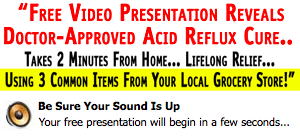April 6, 2011
What Is Acid Reflux Disease
Acid reflux disease, also known as Gastroesophageal Reflux Disease (GERD), is a disease plaguing thousands of people every day. Acid reflux, simply stated, is what happens when the acids from the stomach that are used to breakdown and digest foods escape the stomach and leak into the esophagus causing what is commonly known as heartburn.
How does acid reflux happen?
Acid reflux happens when the circular ring, which is also a muscle, located at the entrance of your stomach and the lower part of your esophagus called the lower esophageal sphincter (LES) doesn’t adequately serve its purpose. The purpose of the ring is to allow for the passing of food from the esophagus to the stomach. As soon as the food passes through, the LES is suppose to close, only opening if there is more food that needs access. If the LES neglects to close all the way or if it opens too often, the acid that is produced by your stomach to break down food can escape your stomach and make its way into the esophagus resulting in heartburn and other acid reflux symptoms. If this happens rarely, you should not be alarmed. However, if this occurrence happens two or more times a week you may be suffering from acid reflux disease.
Another cause of acid reflux disease is an abnormality of the stomach known as a hiatal hernia. This type of hernia occurs when the LES and the upper part of the stomach move above the diaphragm which is suppose to separate the stomach from the chest. The muscle that is the diaphragm serves as a sort of blockade helping to keep stomach acids in the stomach. With a hiatal hernia, acids may travel to the esophagus causing acid reflux disease.
Symptoms of acid reflux disease vary from person to person. While there are those who may experience acid reflux symptoms mildly, there are others that find acid reflux disease symptoms to be quite debilitating. The most common symptom of acid reflux disease is heartburn. Heartburn may be described as a burning or discomfort in the chest. This burning and discomfort has also been known to travel to the throat and lower abdomen. In rare instances, there have been reports of heartburn making its way to the back.
Regurgitation is also a symptom. Regurgitation happens when acids and undigested, recently consumed food and drinks travels up from the stomach into the esophagus and exits the body from the mouth. This symptom has been known to be accompanied by a sour or bitter taste in the mouth as well. Bloating, burping, hiccups, dysphagia (a narrowing of the throat), and in some cases nausea are also known symptoms.
There are ways to lessen the likelihood of acid reflux. The best way to rid acid reflux would be to change how and what you eat. Try eating smaller meals several times a day as opposed to large meals that may overwork stomach acids during digestion. Drink water instead of carbonated, caffeinated and alcoholic beverages. Eat at least two hours before bedtime, and if you are a smoker, quit. Also keep a food log. If you notice that some foods are triggers for acid reflux, eliminate these foods from your diet.
These are just a few suggestions. For more information on acid reflux disease feel free to visit refluxremedy.com.
Filed under Acid Reflux Disease by admin





